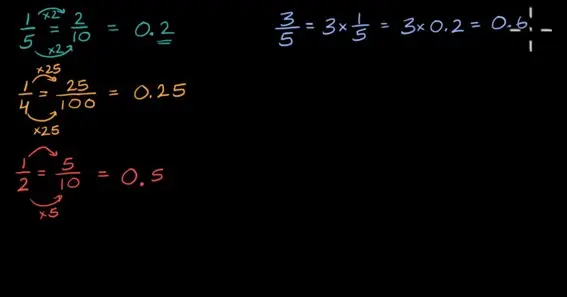Converting fractions to decimals is a fundamental mathematical skill applicable in various fields, including finance, engineering, and everyday calculations. Understanding how to convert 3/5 to a decimal enhances numerical literacy and problem-solving abilities.
Methods to Convert 3/5 to a Decimal
There are two primary methods to convert the fraction 3/5 into a decimal:
1. Division Method
This method involves dividing the numerator by the denominator:
- Step 1: Identify the numerator (3) and the denominator (5).
- Step 2: Divide 3 by 5.
- Calculation: 3 ÷ 5 = 0.6
Therefore, 3/5 as a decimal is 0.6.
2. Equivalent Fraction Method
This method converts the fraction to an equivalent fraction with a denominator of 10, 100, or 1,000, facilitating easier conversion to a decimal:
- Step 1: Multiply both the numerator and the denominator by a number that makes the denominator a power of 10.
- Example: Multiply by 2 to get a denominator of 10.
- Calculation: (3 × 2) / (5 × 2) = 6/10
- Step 2: Write 6/10 as a decimal: 0.6
Thus, 3/5 equals 0.6 in decimal form.
Practical Applications
Understanding how to convert fractions like 3/5 to decimals is useful in various scenarios:
- Financial Calculations: Converting interest rates or discounts from fractions to decimals for precise computations.
- Engineering: Applying decimal values in measurements and specifications.
- Everyday Math: Simplifying tasks such as cooking measurements or dividing expenses.
FAQ
1. What is 3/5 as a decimal?
3/5 as a decimal is 0.6.
2. How do you convert 3/5 to a decimal?
Divide the numerator (3) by the denominator (5): 3 ÷ 5 = 0.6.
3. Is 0.6 a terminating or repeating decimal?
0.6 is a terminating decimal because it has a finite number of digits after the decimal point.
4. Can 3/5 be expressed as a percentage?
Yes, 3/5 equals 60%. To convert a decimal to a percentage, multiply by 100: 0.6 × 100 = 60%.
5. Why is it important to convert fractions to decimals?
Converting fractions to decimals simplifies calculations, comparisons, and interpretations in various mathematical and real-world contexts.
Check out here for a more interesting article rpr-login










